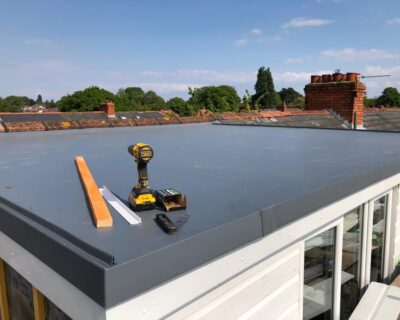Blog & News

How much does it cost to repair a flat roof?
The first thing to keep in mind when it comes to the cost of repairing a flat roof is… that you don’t just repair a flat roof. It’s not by any means a one-price-fits-all question. The price will vary depending on a whole range of factors, such as the size of the roof, the area needing repair, the material you’re dealing with, and so on, not to mention the difference between the cost of doing it yourself and the cost of getting a professional to do it for you, and the potential difference between doing spot repairs and doing full replacements on your flat roof.
The average ballpark figure for replacing a flat roof completely in the UK is between £700-1,300 if done professionally. While that’s not as expensive as, for instance, replacing a pitched roof from scratch, it’s still quite the chunk of change to pay out on a random Tuesday, so let’s be clear. You will probably have some significant warning that your flat roof is losing its integrity before you need to replace it completely. Do not, under any circumstances, convince yourself that the problem will go away if you do nothing about it. That leak, or that bow in the roof, is going nowhere unless you fix it. And the sooner you see to it, the less it’s likely to cost you.
Let’s talk materials.
As we said, the price of the materials will have a bigger impact on the overall costs of repairing your flat roof than the cost of labour. That’s because the cost of labour is standard…ish. Most roofers will work in pairs, work pretty fast, and cost you between £200-£300 per day.
That’s a wide enough window to cover most honest regional variation. The good news is that it will rarely take a pair of roofers more than a day to do any flat roof repair job – often up to and including a full replacement. Hence the relative constancy of the labour costs.
Materials though are a totally different story. You could be looking at quite a range, depending on what your flat roof is made of.
- Felt roof (£40 to £60 per m2)
- Rubber roof (£80 to £85 per m2)
- Fibreglass roof (£70 to £90 per m2)
- Lead bay roof (£90 to £105 per m2)
- Fibreglass bay roof (£95 to £120 per m2)
There’s also some variation depending on what exactly the repair entails. The average cost of a repair (with variation factors based on the materials) depends on how bad the damage is, and how far it has penetrated into the roof.
| Roof Material | Average Cost |
| Base layer | £40 |
| Mid layer | £80 |
| Top layer | £200 |
| Rubber membrane | £220 |
| Adhesive and Sealant | £50 |
| Edgings and drip edge | £140 |
| Resin | £200 |
| Tissue | £30 |
| Topcoat | £130 |
| Trims and baton | £130 |
| OSB boards | £100 |
| Clay | £50 |
What You’re Paying For
While repairing flat roofs depends mostly on the materials of the roof and the level to which the damage extends, it’s worth remembering that different materials will be damaged in different ways – despite exposure to the same stresses and elements. What sort of repair might you be looking at, roof by roof?
Felt Roof
Any leaks through a felt rook run the risk of causing blisters. The repair process involves giving the area an initial cleaning and removing any mould.
Then a heat gun is used to warm up any areas where leaks have occurred, to dry the area completely. Adhesive is applied and a new piece of felt put in place and secured.
If you have splits in your felt, or if it starts to overlap, you can use a similar process, because the cause of the damage will be water.
Rubber Roof
Rule 1 when repairing a rubber roof – no asphalt-based products. They… don’t get on with rubber roofs, and if you use them, you’re going to be staring down the barrel of a complete roof replacement bill.
Simple household cleaners can be used to treat the area and remove the carbon that sometimes leaks out of rubber. That’s necessary before any new rubber will stick.
Your roofer will probably use an EPDM roofing primer and apply a pressure-sensitive patch to the area, making sure it completely covers the area of damaged rubber. An application of EPDM lap sealant will allow the new patch to be smoothed out and secured.
Fibreglass Roof
Fibreglass roofs are prone to holes and cracks. Your roofer will use a disc sander to clean the area and apply a thorough coating of acetone to remove any further debris.
A mixture of resin and catalyst will then be applied and left to set. Once set, it will be sanded down and levelled. Two layers will be cut to size – one the size of the damaged area, and one slightly smaller. More mixed resin will be applied before installing the new fibreglass. One more sanding once the area is cured, and a layer of waterproof top coat to keep the roof weather-resistant as long as possible should see the repair finished.
Lead Roof
The main issue with lead roofs tends to be cracks due to heat expansion of the roof material and the flashings.
To fix the hole or crack, your roofer is likely to weld on a replacement piece of lead to the damaged area.
Your roofer may also use flashing tape to secure the roof material, and a primer to act as an adhesive to keep the lead in place. That’s fine in the short term, but ultimately it’s not a long term solution. Welding new lead in place solves the problem for significantly longer, so it’s the chosen option for most professional repairs to lead roofs.
This is where your money is going when you call in a professional roofer to fix the damage to your flat roof. As we said at the start, waiting when you see damage to your flat roof is like waiting when you see your money going up in flames. The sooner you react to flat roof damage, the less serious the damage is likely to be, and the less you’re likely to have to pay, certainly in materials and probably in time too.



